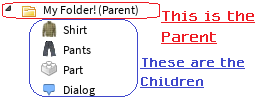Children & Parents (in scripting)
In scripting, children are the objects placed under another object, and the object holding the child is called the parent. Think of the parent as a house, right, and think of the children as the things inside that house. The parent objects essentially house those children objects. We call these terms "hierarchy terms."

On this image, it shows the parent and the children. If we put a script inside of the part, how would we refer to the folder inside that script? Well, since the script would be inside of the part, we would have to first use "script.Parent" which refers to the Part itself. Then, if we want to get the parent of the part, we simply do "script.Parent.Parent", which would refer to the Folder. The folder would be 2 levels from the script, so we would have to use ".Parent" 2 times